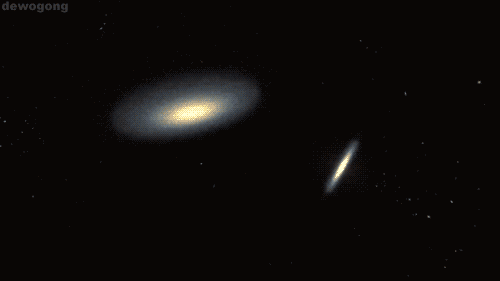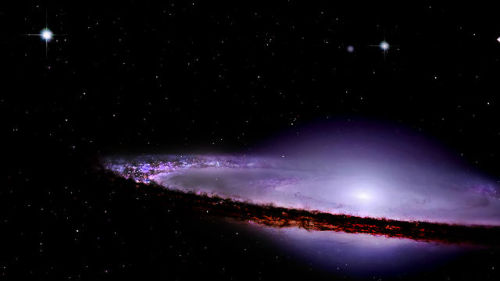Wow, This Is Really Cool Thank You!
Wow, this is really cool thank you!
ATTN. @ NERDS
Since I am also a nerd and follow NASA on Facebook, I found this. Thought someone might be interested.
More Posts from Alitheastronomer and Others

Hickson 91 in Piscis Austrinus by Johannes Schedler
More cool space words:
Apastron: the point where two binary stars are farthest apart.
Azimuth: distance of an object in angular.
Bolide: an especially bright meteor, especially one that explodes in the atmosphere (also called fireballs!).
Catena: a chain or series of craters.
Ejecta: material that is strewn about a crater by an impact, usually a meteorite or other similar object.
Ephemeris: a table that lists the positions of the sun, moon, and planets by date.
Heliosphere: the magnetic bubble of space that contains our solar system, solar wind, and the entire solar magnetic field. It is so large it goes beyond pluto's orbit.
Meridian: an imaginary circle that goes through the north and south poles, and the zenith and nadir of a location.
Nadir: the point in the sky directly underneath you.
Nova: when a dying star suddenly flares in brightness. The star becomes thousands of times its original luminosity.
Prominence: an explosion on the surface of the Sun.
Singularity: the impossibly small space in the center of a black hole where density and gravity are infinite, and space-time curves infinitely.
Spicules: a jet of gas ejected from the sun's atmosphere that resembles grass.
Supernova: one of the most powerful forces in the universe. When a star uses up all of its fuel it ends its life in a spectacular and devastating explosion.
Terminator: line on a planetary body that separates the light side from the dark side.
Umbra: the darkest part of a shadow.
Zenith: the point in the sky directly overhead.
Zodiac: an imaginary belt across the sky that the sun, moon, and planets are always in. The zodiac is made up of 12 constellations.
pretty space words
aphelion - the point in the orbit of a planet, asteroid, or comet at which it is farthest from the Sun. astral - relating to or resembling the stars. caldera - a large volcanic crater, especially one formed by a major eruption leading to the collapse of the mouth of the volcano. celestial - positioned in or relating to the sky, or outer space as observed in astronomy. constellation - a group of stars forming a recognizable pattern. cosmos - the universe seen as a well-ordered whole. equinox - the time or date at which the sun crosses the celestial equator, when day and night are of equal length. faculae - bright patches that are visible on the Sun’s surface. lunation - the interval of a complete lunar cycle, between one new Moon and the next. interstellar - occurring or situated between stars. nebula - a cloud of gas and dust in outer space, visible in the night sky either as an indistinct bright patch or as a dark silhouette against other luminous matter. perihelion - the point in the orbit of a planet, asteroid, or comet at which it is closest to the Sun. synodic - relating to or involving the conjunction of stars, planets, or other celestial objects.

New Horizons image of Jupiter and Io
Coppery reds of upcoming lunar eclipse may be accented with turquoise
Washington (UPI) Oct 1, 2014 Next Wednesday, Oct. 8, the full moon will turn a coppery red as a lunar eclipse becomes visible across the entirety of the United States. “It promises to be a stunning sight, even from the most light polluted cities,” Fred Espenak, NASA’s resident eclipse expert, said in a recent press release. “I encourage everyone, especially families with curious children, to go out and enjoy the ev Full article


The stunning Sombrero galaxy (seriously, there should be a blog that’s just photos of the Sombrero galaxy)
Phase of the moon affects amount of rainfall
Seattle WA (SPX) Jan 31, 2016 When the moon is high in the sky, it creates bulges in the planet’s atmosphere that creates imperceptible changes in the amount of rain that falls below. New University of Washington research to be published in Geophysical Research Letters shows that the lunar forces affect the amount of rain - though very slightly. “As far as I know, this is the first study to convincingly connect t Full article
![A Multi-Camera 360° Panoramic Timelapse Of The Stars By Vincent Brady [VIDEO]](https://64.media.tumblr.com/4e12ed79b6fa93fbd2f17ccd004921d6/tumblr_n7h573O5RR1rte5gyo1_500.gif)
A Multi-Camera 360° Panoramic Timelapse of the Stars by Vincent Brady [VIDEO]
An eclipse, caught from a plane.




Four beautiful examples of overlapping/interacting galaxies brought to you by the Hubble Telescope. To view the images in their full resolutions, please open them in a separate tab.
-
 alitheastronomer reblogged this · 9 years ago
alitheastronomer reblogged this · 9 years ago -
 imkerfuffled liked this · 9 years ago
imkerfuffled liked this · 9 years ago -
 alioopshi reblogged this · 9 years ago
alioopshi reblogged this · 9 years ago -
 firebreathing-bookworm liked this · 9 years ago
firebreathing-bookworm liked this · 9 years ago -
 clearbroth liked this · 9 years ago
clearbroth liked this · 9 years ago -
 jazzhandsmcleg reblogged this · 9 years ago
jazzhandsmcleg reblogged this · 9 years ago -
 jazzhandsmcleg liked this · 9 years ago
jazzhandsmcleg liked this · 9 years ago -
 firebreathing-bookworm reblogged this · 9 years ago
firebreathing-bookworm reblogged this · 9 years ago